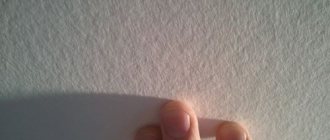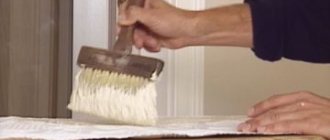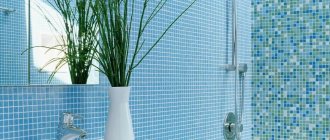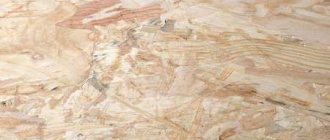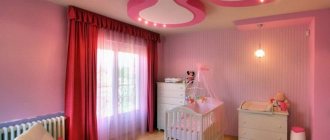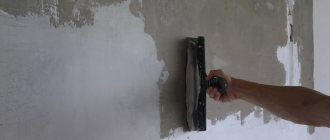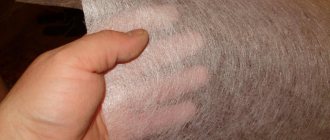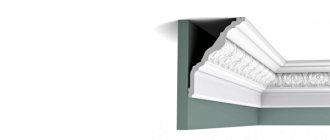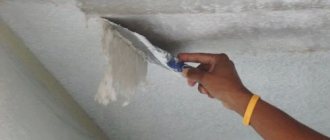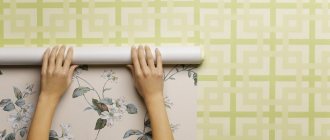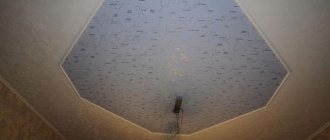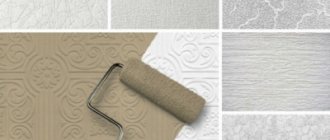Application of fiberglass for ceiling
When looking at this material, it may seem that it is not very durable and can be easily damaged. Indeed, if handled carelessly, fiberglass for ceilings even breaks. But when glued in compliance with the technology, it is capable of forming a reinforcing layer of excellent quality.
The material does not allow cracks to spread further when they already exist on the ceiling surface, and in the future it will prevent the appearance of new ones. Fiberglass for ceilings is supplied to the retail chain in rolls up to 50 meters long and 1 meter wide.
Depending on the density, which varies, this material is divided into several classes. The retail chain offers customers fiberglass with a density of 25 to 50 g/m². The thickness of the ceiling web for painting directly affects its cost.
For gluing the ceiling surface, products with a density of 25 g/m² will be sufficient. This indicator can ensure the formation of a light and at the same time durable reinforcing coating. In cases where the surface does not seem entirely reliable, in order to prevent destruction of the rough base, you can use fiberglass with a higher density.
Types and parameters
In construction, three main types of gossamer fiberglass are used - with a density of 25, 40 and 50 g/m2. The first option, 1 m2 of which weighs only 25 grams, is optimal when painting ceilings, since the lower weight increases the convenience of gluing. Because of this, the material is often called “ceiling cobweb”. In addition, fiberglass with a low density absorbs less paint. However, it can only be used if there are no large surface irregularities or cracks.
“Spider web with a density of 40 g/m2 is considered universal, since it is almost twice as strong as lightweight material and cheaper than thicker options. This option is chosen for subsequent painting of surfaces that are more likely to be damaged than the ceiling. It is permissible to use fiberglass for ceilings finished with dilapidated plaster, and in rooms with high vibration loads.
One of the most durable types of “gossamer” - a material with a density of 50 g/m 2 - allows you to close cracks of significant size. Withstanding a large mechanical load, it may become the only option for finishing the premises of a production workshop, workshop or garage, where the likelihood of damage to the enclosing structures is much higher. The cost of its installation increases - both due to the price of the “gossamer” and due to the fact that the higher density also increases the consumption of glue for fiberglass web. Due to the significant costs, this option is practically not used in residential buildings and apartments.
Manufacturing of fiberglass for ceiling surfaces
This material is produced by melting glass of a special composition. Fiberglass for the ceiling is an environmentally friendly product, since quartz sand, soda, lime and dolomite are used for its production. When the melt is heated, threads are formed, then they are randomly layered on top of one another and glued together.
Outwardly, they look like a cobweb, which is difficult to break. At the same time, glass fibers bend easily without being deformed, and their structure is not disturbed. Next, the material is pressed to give it increased strength.
As a result, the produced fiberglass ceiling has the following qualities:
- environmental cleanliness;
- fire resistance;
- water resistance;
- resistance to damage.
In addition, this material has antistatic properties, and due to its inorganic composition it is not subject to mold formation.
Benefits of using fiberglass
The use of glass fiber webs helps prevent troubles with the decorated ceiling surface during subsequent operation:
- First of all, its use can significantly improve the condition of the base for further finishing with paints or wallpaper.
- Fiberglass increases the strength of the ceiling. This means that over time it will not become covered with cracks and chips will not appear on it, which could harm the finish and significantly spoil its appearance.
- The ceiling canvas has the ability to not be afraid of exposure to water, so it can be wet cleaned using chemical care products. This will not affect the condition of the ceiling canvas in any way.
- Since fiberglass is a non-flammable material, in the event of a fire it will not support the further spread of fire.
- Due to the unusual interweaving of threads, the material has an original pattern that looks interesting.
- The painting web is mounted on concrete bases with a layer of plaster, on gypsum plasterboard structures and on extrusive polystyrene foam. The latter material is often used for the purpose of thermal insulation of rooms, including when laying insulation on the ceiling inside a room.
Types of installation
There are two ways to glue the material: joint to joint or overlap. Their choice directly depends on the light source in the room. It is necessary to immediately assess the situation and determine what will be less noticeable: the joints or seams of the fiberglass strips.
The glass sheet must be glued to the plasterboard surface, joint to joint.
This is due to the fact that the rough surface made of HA perfectly absorbs moisture. After impregnating the fiberglass with glue, its structure will begin to swell. In some places there may be excess material that needs to be trimmed. It is better to avoid such modifications, as the structure of the canvas is disrupted. This will lead to loss of technical characteristics of the material.
Gluing fiberglass for painting
Before gluing fiberglass to the ceiling for painting, you need to prepare the surface in a certain way. All remnants of old finishing materials – paint, wallpaper, whitewash and plaster – should be removed. It is advisable to clean off the whitewash with a spatula and then wash it off with a rag moistened with plenty of water.
During the cleaning process, potholes will become visible on the ceiling surface, which should be primed and puttied. But the best solution is to putty the entire plane of the ceiling.
Next, proceed to applying the primer. This work is carried out after the finishing layer of putty has dried. The composition is applied generously. The drying period is usually 20-30 minutes. Abundant impregnation provides better adhesion to the glue and, accordingly, to the painting web. At the same time, experts advise using not a regular primer, but a deep impregnation agent.
After the primer has completely dried, before gluing the fiberglass to the ceiling, the glue should be diluted. You can only use special compounds for working with this material. As a last resort, PVA-based glue can be used.
There are unlikely to be any problems purchasing special adhesives for fiberglass, since they are sold in stores in the form of dry powder in packs or in liquid form in buckets.
If you purchased powder, then the contents of a 300-gram pack must be diluted in 11 liters of cold water and mixed until smooth. This adhesive composition should be enough to cover 50 square meters of ceiling surface with fiberglass.
Next, they begin gluing the painting web, observing a number of conditions:
- the room temperature should be in the range from +18 to +25°C;
- absence of drafts;
- The material cannot be exposed to direct sunlight.
Gluing fiberglass to the ceiling is carried out in a certain sequence:
- A piece is cut from the roll and cut into pieces of the required size, leaving a small margin. The canvases are usually fixed end-to-end. The adhesive is applied to the ceiling with a wide brush or roller to an area of coating equal in width to the fiberglass. A piece of material is applied to the surface on which the adhesive composition is spread and smoothed in the direction from the center to the edge. This procedure is carried out with a plastic spatula, used when wallpapering walls.
- Excess fiberglass is cut to length. This should be done extremely carefully, avoiding strong pressure, since the painting web is a very vulnerable material and can be easily damaged. The entire ceiling surface is covered in the same way.
- At the final stage, the fiberglass is coated on top with an adhesive composition. The pasted canvases dry completely within one day. As a result of finishing the ceiling with fiberglass, a high-quality reinforcing layer is formed. It turns out to be so durable that you don’t have to think about the need for repairs in this part of the room for a long time.
Sometimes it happens that a piece of painting web can tear on the side. In this case, adjacent sheets have to be overlapped by about 3-5 centimeters. You will have to apply the adhesive composition to the next ceiling section and the part of the piece on which you plan to apply fiberglass.
To avoid leaving a strip of the double layer of material, since it will begin to stand out strongly after applying the paint, the application area should be cut in waves with a sharp wallpaper knife. Next, excess layers are removed from each part of the canvas, and the existing joint is carefully smoothed with a spatula.
Tools, materials
To work you will need:
- stepladder or construction sawhorses;
- protective glasses;
- gloves;
- respirator;
- detergents or solvents to remove the old paint layer;
- putty;
- deep penetration primer;
- ruler;
- chalk or simple pencil;
- roll of fiberglass;
- scissors;
- construction knife;
- sharp metal and plastic wallpaper spatulas;
- glue container;
- glue;
- wide flat or round brush;
- serpyanka or mounting tape.
Using fiberglass on a ceiling for painting
Since the finishing of the ceiling surface is carried out indoors, the best solution would be to use interior types of paints, for example, water-based or acrylic. They do not have a pungent odor, they dry quickly and are able to advantageously highlight the structure of fiberglass ceilings for painting.
To obtain the best result when applying the coloring composition, it is advisable to use a roller with medium nap. When the tool comes into contact with the web, it should not be dry, so it must be thoroughly soaked in paint.
In order to process all the depressions and bulges on the fiberglass ceiling for painting evenly, you should roll the roller along the surface in two directions alternately - horizontally and vertically. After the first layer has dried, only then apply the next one. Usually, two times are enough to get a beautiful and durable coating.
Let's sum it up
A properly glued “cobweb” creates the appearance of completely smooth walls and ceilings in the room. Therefore, it is often used as a base for decorative plasters, the defects of which are especially noticeable. Thus, fiberglass solves some of the problems that arise during finishing work and increases the service life of the ceiling or wall decoration. And the owner of the premises saves on this repair and increases the time before the next one begins.
How to treat the surface → Room decoration → How to choose the right paint → Surface treatment technologies → Leveling and finishing the walls → Selecting and applying a primer → Removal from the surface → Stretch ceilings and technologies → Reviews and testimonials
Getting a mirror surface effect
This finishing option looks very original, but the list of work that needs to be done will be supplemented with one more item - this is applying a layer of putty when the adhesive composition has dried. To do this, use a rubber spatula, and make the consistency of the solution more liquid than always.
It must be applied in a thin layer so that the fiberglass on the ceiling to be painted is evenly covered. The putty must dry well and then fine-grained sandpaper is used to treat the surface. Sanding is carried out carefully so as not to accidentally damage the applied layer and not to reveal the structure of the painting web. Then the surface is primed.
Installation methods
Fiberglass or glass wallpaper are rolled materials. Their installation is carried out only using adhesive solutions. You can also use simple glue for non-woven or vinyl wallpaper.
The choice of product directly depends on the quality characteristics of the surface being coated.
If you need to install fiberglass on plasterboard walls, it is better to use specialized products. They will help securely secure the material.
Fiberglass sticker on plasterboard ceiling
Ceiling structures using plasterboard sheets are often installed. When finishing them, fiberglass is used as a reinforcing coating. Experts recommend using this material regardless of whether or not there is serpyanka at the joints of the gypsum plasterboard for strengthening.
When working with drywall, the web prevents its deformation, since this building material can be stored in a store in improper conditions and absorb, for example, moisture.
The technology for gluing fiberglass, used as an intermediate layer between the sheets and the final finish, is similar to the algorithm described above for carrying out such work. The difference lies only in the nuances of surface preparation.
Therefore, before gluing the web to the gypsum board, you should:
- putty the places where the screws enter and the seams between adjacent plasterboard slabs;
- Apply a layer of glue over the entire ceiling area, which in this case will act as a primer - it will prevent the next adhesive layer from being absorbed;
- wait for the adhesive to dry completely and begin gluing the fiberglass.
Care instructions
Surfaces covered with fiberglass material do not require special care. The web is not electrified, so the finish is resistant to dust and other contaminants. For regular cleaning, you can wipe the coating with a damp cloth without using aggressive detergents. Dry cleaning with a vacuum cleaner is also allowed.
Canvases made from glass threads are primarily intended for reinforcing wall and ceiling surfaces and protecting coatings from cracks. But this is not the only function they perform. Another feature is the leveling of surfaces. Also, many people prefer to leave the structure of the web in its original form and not cover it with putty, but use it as a decorative element.
The large number of different functions that fiberglass performs makes it a real find for those who decide to renovate their home. It not only solves many problems associated with finishing, but also saves money.
The difference between fiberglass and glass wallpaper
Painting web and glass wallpaper are not the same finishing material. They have some similarities, which consist in the ability to strengthen the surface being formed and in the coincidence of characteristics regarding fire resistance and wear resistance.
There are significant differences between glass wallpaper and fiberglass:
- Regarding the production method. Fiberglass wallpaper is a woven material, but painting web is not. Fiberglass has a smooth structure, while wallpaper has a textured structure.
- Fiberglass ceilings for painting can be repainted an unlimited number of times, but its opponent will not withstand more than 25 color changes.
- The painting web serves as an intermediate reinforcing layer, and the glass wallpaper is intended for finishing.
- Fiberglass is inferior to wallpaper in terms of density: 25-65 g/m² versus 150-225 g/m². There is also a big difference in weight.
- The prices of these products are completely different. The price for cobwebs is about 2 times less than for wallpaper.
Companies producing glass fiber ceilings
Oskar brand fiberglass is produced in Russia. Its density ranges from 25 to 50 g/m². These products are affordable and highly durable. The material can be repainted many times, and it does not require much paint consumption.
In Finland they produce painting webs under the Wellton brand. Fiberglass from this manufacturer is popular among consumers; it can withstand repeated repainting.
Also, high-quality fiberglass is produced in Holland under the Spectrum brand and in China under the Nortex brand. Ecotex web has proven itself well.
Which manufacturer to give preference to, and which fiberglass is best for the ceiling, each homeowner decides independently. If it is difficult to make a choice, you can ask for reviews about a particular product. In itself, pasting the ceiling plane with fiberglass is not a complicated process and therefore such work can be done on your own.
Preparing wallpaper glue
How to glue: French glue “Quelyd” is reliable
After purchasing fiberglass, you need to select glue. There is a special glue for this type of wallpaper. You can also use glue for heavy or non-woven wallpaper. The glue is prepared immediately before gluing the glass wallpaper.
How to glue glass wallpaper to the ceiling: the process of preparing wallpaper glue
Important! The adhesive composition must be prepared exactly following the manufacturer's instructions. The dry adhesive mixture is poured into the required amount of warm water and mixed well. The finished glue should stand for about 10-15 minutes to swell. After this, the glue needs to be stirred again.
You can also purchase ready-made glue.
